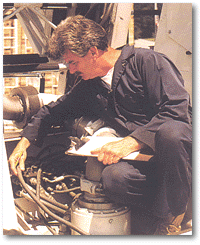TESTING & INSPECTION IS DIVIDED INTO FOUR INTEGRAL PHASES:
The content of each part had a developed set of check lists specifically designed to be carried out in a systematic sequence with proper attention to detail:
I. Visual Inspection
Each aerial device is examined for compliance with the manufacturer's guidelines along with the National Fire Protection Association standards:
 |
• NFPA 1901 • NFPA 1911 • NFPA 1912 • NFPA 1914 • NFPA 1915 |
Visual examination of the equipment is intended to detect visible defects, damage, or improperly secured parts.
The entire aerial unit, from below the truck to the tip of the aerial is visually inspected for defect, alignment, fastener security, deterioration, corrosion or any other abnormal condition. Each component is documented in our developed set of check lists specifically designed to be carried out in a systematic sequence with proper attention to detail. Some areas of inspection include:
● Torque Box and Mounts
● Hydraulic System Circuits
● Electrical System and Interlocks
● Fasteners and Retainers
● Pivots and Lubrication
● Emergency and Marker Lights
● Hydraulic Hoses and Valves
● Cables and Sheaves
● Slide Tracks and Pads
● Turntable and Ladder Structure